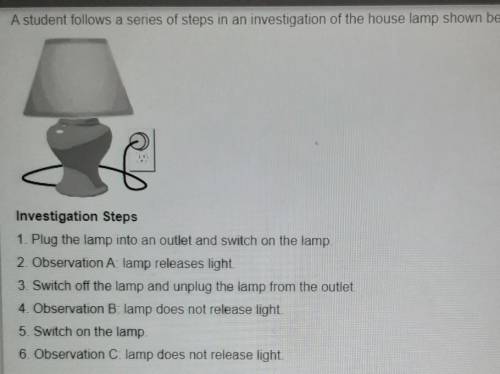
A student follows a series of steps in an investigation of the house lamp shown below.
What argument does observation C BEST support?
Answer choices:
A. The lamp stopped creating electrical energy.
B. The lamp was turning electrical energy into light.
C. Switching the lamp on and off several times in a row broke the lamp.
D. the lamp destroyed all of the energy in the outlet.


Answers: 2


Another question on Physics

Physics, 22.06.2019 12:30
Apositive charge moves in the direction of an electric field. which of the following statements are true? check all that apply. check all that apply. 1.the potential energy associated with the charge decreases. 2. the electric field does positive work on the charge. 3. the electric field does negative work on the charge. 4. the potential energy associated with the charge increases. 5. the electric field does not do any work on the charge. 6. the amount of work done on the charge cannot be determined without additional information.
Answers: 1

Physics, 22.06.2019 20:20
The base of a 50-meter tower is at the origin; the base of a 50-meter tree is at (0, 50, 0). the ground is flat and the z-axis points upward. the following parametric equations describe the motion of six projectiles each launched at time t = 0 in seconds. (i) r (t) = (50 + t2)k (ii) r (t) = 2t2 j + 2t2k (iii) r (t) = 50 i + 50 j + (50 − t2)k (iv) r (t) = 2t j + (50 − t2)k (v) r (t) = (50 − 2t) i + 2t j + (50 − t)k (vi) r (t) = t i + t j + tk (a) which projectile is launched from the top of the tower and goes downward? at time t = , the projectile hits the ground at point (x, y, z) = . (b) which projectile hits the top of the tree?
Answers: 2

Physics, 22.06.2019 21:30
Contrast the force of gravity between these pairs of objects: 1-kg mass and a 2-kg mass that are 1 m apart; a 1-kg mass and a 2-kg mass that are 2 m apart; and two 2=kg masses that are 1 m apart. i dont understand.
Answers: 3

Physics, 22.06.2019 22:00
The inside surface of a cylindrical-shaped cave of inner diameter 1.0 m is continuously covered with a very thin layer of water. the cave is very long and it is open on both ends. the water on the cave surface is at a constant temperature of 15.5 °c. the cave is constantly exposed to wind such that 15.5 °c air flows through the cave at 4.5 m/s. the kinematic viscosity of the air is 14.66 x 10-6 m2/s and the molecular diffusion coefficient of water vapor in the air is 0.239 x 10-4 m2/s. because the cave diameter is so large, the flow of wind down the length of the cave, in the x direction, can be treated like it is external flow and the cave surface can be approximated as flat where appropriate. calculate the x value, in a) the transition to turbulent flow occurs at rex meters, where the air flow transitions from laminar to turbulent along the inside surface of the cave b) calculate the x value, in meters, where the bulk steady state concentration of water vapor in the air flowing in the cave is 10% of the saturation concentration. assume the air at the surface of the water layer is 100% saturated with water vapor. assume the wind entering the cave contained no moisture before it entered the cave. take into account the transition from laminar to turbulent flow when solving part b
Answers: 1
You know the right answer?
A student follows a series of steps in an investigation of the house lamp shown below.
What argumen...
Questions

Mathematics, 11.01.2020 06:31

Mathematics, 11.01.2020 06:31


Biology, 11.01.2020 06:31



History, 11.01.2020 06:31

Mathematics, 11.01.2020 06:31

History, 11.01.2020 06:31

Mathematics, 11.01.2020 06:31

Mathematics, 11.01.2020 06:31


Mathematics, 11.01.2020 06:31


Biology, 11.01.2020 06:31




Mathematics, 11.01.2020 06:31



